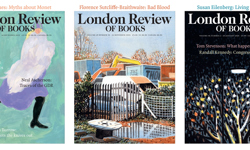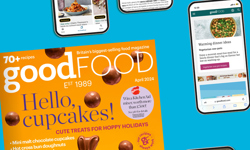As a casual reader, it’s difficult to know where to start with Love. It’s dauntingly big, heavy and colourful and my cover was refreshingly clear of shouty coverlines.
The contents are on page 95. Everything before it is a full-page ad, beautifully designed and shot from Calvin Klein, Givenchy, Chanel, Burberry and just about every marquee fashion brand you can think of.
According to the disappointingly out-of-date online rate-card (talks of a December 2012 deadline) a run of paper page of advertising will set you back £10,500. So before you even get to the contents that’s… well, you do the math.
Elsewhere, the style mags are fighting for readers and advertisers in a variety of ways. Here’s how they measure up…
LOVE
What’s it about: “Love is a twice-yearly compendium of inspiration – for designers, for artists, for anyone looking for visual ideas; for anyone who loves fashion and design so much that they want to climb inside the heads of their heroes.” - blurb on website.
Vital statistics: Autumn / Winter 2014 issue: 510 pages of 310 x 230mm (just a bit wider than A4); £6 cover price.
Cover: Pic of model Christy Turlington (Burns) promoting their ‘American Girl’ theme, just one of four covers for the issue. The other cover stars are actress Amy Adams, model Adriana Lima, and model / reality show star Kendall Jenner.
Content: Ads, ads and more ads; some amazing photo shoots including eight pages of model Cara Delevingne laying on beds of sweets such as liquorice allsorts; Q and A features; longer-form writing, including a spiky interview with model Kendall Jenner, daughter of Kris Jenner (formerly Kardashian. Yes, related); acres of beautiful people doing beautiful things in beautiful places.
Difficult to tell where the ads end and the editorial begins, but Condé Nast are masters of that trick. Looks fantastic, but big and unwieldy… and definitely not one for the handbag.
Digital: A somewhat bizarre website with happy snappy pix from events and links to archive material. Plus little animals floating randomly across the screen (don't ask).
What they say: Katie Grand, editor in chief of Love Magazine on Twitter @kegrand: “Fun day out with @caradelevingne @kimkardashian @thelovemagazine http://instagram.com/p/tkp6KFt5zr/”
SUITCASE
What’s it about: ‘Travel + Fashion’ - tagline under masthead
Vital statistics: Summer 2014 issue: 162 pages of 244 x 185mm (drunken, shrunken A4); interesting mix of matt and gloss paper; £5 cover price.
Cover: Model pic from 10-page ‘The Girl From Ipanema’ fashion shoot. Spare design with no cover lines.
Content: Does what it says on the tin: Travel + Fashion. Sumptuous coverage of both with exquisite photography and some decent long reads. Neat fusion ideas like #livinginmysuitcase and celebrity interview, in this issue 'Scarlett's (Johansson) Suitcase'.
Digital: Neat and functional, just like the magazine. Clear and easy-to-find social media links with all the usual suspects plus featured videos on Vimeo.
What they say: Editor Serena Guen talking to thefoxisblack.com: “I feel like if you want a magazine to be successful, it can never be just a magazine — it is a vehicle for something and for me Suitcase is a gateway to travel that young people haven’t necessarily had access to before. With that in mind, we are constantly coming up with ways of how to make travel and local cultures exciting, understandable and, of course, accessible. A print magazine was a fantastic starting point but we have so much potential to expand in different ways that it is simultaneously extremely exciting and slightly daunting.”
FRANKIE
What’s it about: ‘Design/art/photography/fashion/travel/music/craft/home/life’ - tagline under masthead.
Vital statistics: Issue 59: 146 pages of 276 x 210mm (A4 width, 20mm shorter); Matt paper; £7.50 cover price.
Cover: Artwork illustration. No cover lines.
Content: “Making a documentary about her genitals was never on Phoebe Hart’s to-do list.” So starts a series of three quick interviews with documentary makers. Of course, she does make that film…
Everything that it boasts on the cover tagline is in there. And all with an Aussie slant.
Cut-out-and-keep wallpaper not to be missed.
Digital:www.frankie.com.au is a busy little website heralded by the following: “Welcome to Frankie magazine online, the digital way to quench your Frankie thirst in between issues. Here you will find lots of nice bits and bobs including clothes, music news, craft, photography, travel, Australian events and more.”
What they say: Frankie co-founder Louise Bannister in an interview with thethousands.com.au: “I get inspired by talking to friends and family. You might be talking to them about something random and then think, hey that's a great book idea. It's funny how many ideas are right in front of you.”
And @frankiemagazine on Twitter: “it's our duty to make you aware of this mind-blowing fact: A RECIPE FOR LICKABLE WALLPAPER EXISTS”
MONOCLE
What’s it about: ‘A briefing on global affairs, business, culture & design’ - tagline under masthead.
Vital statistics: Issue 75, July / August 2014: 300 pages of 265 x 200mm (maxi handbag); £7 cover price.
Cover: Busy, busy, busy. A total of 23 separate text x-refs, eight numbers, and five letters (A-E). Four pictures (including dogs and beautiful young people) and a rather understated masthead that gets a bit lost.
Content: Sumptuous. Monocle is the size and cost of an airport paperback and doesn’t disappoint. Lots of hard-licks journalism with fact-boxes, break-outs and quotes galore. Content set out A to E (Affairs, Business, Culture, Design, Edits) on decent gauge matt paper.
Digital: You can see but you can’t touch. All the content is there, but greyed out under ‘Subscribe Now’. No visible social media links.
As Tyler Brûlé, editor-in-chief of Monocle, told the London Evening Standard: “Monocle’s website has always charged subscribers who pay £80 a year to view articles as well as getting the print edition. It’s just common sense. Why would we generate all of these stories and invest in editorial and annoy our core readership by giving it all away free?”
What they say: Brûlé himself isn’t on Facebook or Twitter. “I don’t have to be. I’ve got a magazine.” He takes a similar view about tablet and iPad editions. “We’re not the most app-tastic company in the world. I say: ‘Look, where’s the money in this?’”
WONDERLAND.
What’s it about: Not sure. No clues on the magazine, but ‘Video, fashion, Music, Celebrity, Etc’ tagline on website
Vital statistics: Summer 2014 issue: 322 pages of 297 x 230mm (just a bit wider than A4); £5 cover price.
Cover: Pic of Mariah Carey (underwear photoshoot inside) plus names of other people featured. Large Wonderland. masthead. Complete with full point, a conceit not carried on inside.
Content: Big glossy fashion pix, mainly just one subject per page, some well written features, but nothing too taxing or long. A strangely naïve design, using a blocky sans typeface and lots of unnecessary white space.
Digital: Easy click-throughs to content as advertised above, plus a tawdry ‘Top Five Sex Tapes’. The Facebook counter had already clicked up to 1750 in just a few days so must be hitting the spot. Breathless Twitter feed @wonderlandmag
What they say: Huw Gwyther, editorial director & publisher of Wonderland in an interview with the Independent: “I always loved magazines – Smash Hits and The Face, then Vogue and Harper's Bazaar – because I escaped reality into an amazing fantasy. So I wanted to be someone who put a magazine together.
“I realised I didn't want to work for someone else, so I came back to the UK and did a business plan and approached investors. When I heard about Dragons' Den, I knew the panel of five had the money to get my business off the ground, even if it meant I'd have to go on TV. Four people dismissed it as too risky, but Peter Jones took a gamble. I raised £200,000, including Peter's investment, and that was enough to start.”












